Please use the following link to download the June 18, 2022 issue of the syəcəb
Category: Tulalip News
Chairwoman’s Report for June 16, 2022
I would like to give a brief update of what the Board of Directors has been working on.
On April 22nd, I received an invitation to go to Seward Park for Earth Day, where President Biden was signing a Force Protection Act. There were many representatives and senators at the signing, along with four other tribal chairmen.
As you know, we’re always looking at what we could do to clean up our lands, to protect our forests, for the next generations.
On May 3rd, Vice-Chairwoman Misty Napeahi and I were invited to a dinner at Lake Washington in Seattle where Nancy Pelosi spoke along with other Democratic representatives. They were there to bring us the message on continued support for the Democratic Party in the upcoming elections.
We are having continued meetings with Snohomish County about the health districts not following through on nuisance property and failing septic systems. This is a big issue because where the drain fields are going is back into our water supply and causing contamination where it seeps to the surface. It’s really an issue that our Compliance Department is trying to take care of with Snohomish County, but we had to bring it to the table to those above them to make sure this is happening. We have also asked about the possibility of taking over jurisdiction of all of this. We will be continuing these talks with Snohomish County
I would also like to talk about the election that’s coming up for our state representative in the 38th District One. We have Daryl Williams, who is a tribal member who’s actually worked for the tribe for over forty years in Tulalip’s Natural Resources Department and legislature.
We’re really excited about bringing his experience forward and making sure that we have a seat at the table with one of our tribal members. Ballots will be mailed out on July 14th and have to be returned by August 2nd. Darryl has a long history of working for our tribe and he’s also been in Olympia with us, representing the Tribe and all kinds of cases, especially those concerning natural resources.
If elected, some of Darrell’s priorities are to take care of the chronic homeless, deal with addiction and mental health issues, and also address living wage jobs because it’s so important to be able to take care of your families. But, his biggest priority and expertise is in the environment and how we need to clean up the streams to take care of our salmon and to continue our way of life.
We recently held a meeting on the constitutional amendments. We, the Board, all worked together and we went through everything. We wanted to clean it up, do some housekeeping, and to bring it into the 21st century. We took out language where it said he and put he/she, from Chairman to Chair and also took out Indian and replaced it with Native or Native American.
We also removed the sections about allotted land because that doesn’t apply anymore. It also talked about landless Indians because these constitutions were sent out by the BIA and there were templates back in 1936. This is just our first stage in the constitutional amendment. We’ll have one more meeting prior to the Board taking a vote to send it to the BIA.
It has to go through the BIA process to change the Constitution. They will send out documents describing what needs to be done. Each person will have to register to vote with the BIA and at that time there will be 90 days in between when they receive our constitutional amendment and that election process will happen if they approve it to move forward.
Of those who register, 30% have to participate in the vote to have it to be a legitimate vote, and then the majority will rule. Now, this is just for the clean up section to make sure that we update our Constitution. This has been needed for a long time and we’re glad that we’re finally at this point.
This was something that was brought forward at the General Counsel and we wanted to do it within that time frame and we have accomplished our first meeting by that timeframe. We’re proud to have got that far. So we will be setting one more meeting with changes that were brought forward at the meeting.
We recently approved the Washington Department of Fisheries and Wildlife Memorandum of Understanding (MOU) and what that does is protect the Tribe and moving forward with the issues that we had in the past.
So prior to bringing any issues out onto the Reservation, they have to forward them to our Fisheries and Wildlife Department and to our Police Department to handle the issues. The MOU outlines the rules that we will follow, and the process of doing so, to make sure that we respect each other’s jurisdiction and that we hold our jurisdiction on this Reservation.
We have started some spring cleanup and as you all know, there have been dumpsters delivered to some of our housing development sites. Public Works will also be picking up refrigerators and stoves upon request, and they are also working with the Tulalip Police Department on removing unwanted junk vehicles on your property. Contact Officer Jim Williams at 360-716-5990 for more information.
Now is the time of year you can start to get out and to do gardening and clean up your area, but it takes everybody to do their part. This land is sacred, so we need to protect it. We just recently finished the Salmon Ceremony and it was a wonderful event. We are really excited about all of the youth that were involved.
It’s good to pass the culture on to the next generation. When we talk about that, we talked about it at the Salmon Ceremony, how you started out with my father’s generation that passed it down to mine. There are five to six generations that have been involved in the Salmon Ceremony, and with this being its the forty-sixth year, it was really exciting to see all of the youth involved.
We have a number of events that are going to be happening very soon.
On July 16th, we will be having our Spee-Bi-Dah event. Then on July 21st through the 26th there will be a canoe trip to Lopez Island. There will also be a recovery trip that’s going to be up there. They’ll be camping there and fundraising to bring people who are fresh in recovery out to camp.
The Membership Financial Meeting will be held on June 23rd at 5 p.m. in the Orca Ballroom. Prior to the meeting, you can pick up your financial booklets at the Board Reception on June 21st between 1pm – 4pm.
August 18th, there will be the Elders luncheon at Tulalip.
August 20th through the 21st, we will be hosting the canoe races here at Tulalip.
There will also be the annual Marysville Strawberry Parade this Saturday June 18th and it starts at 7:45 p.m. I would like to congratulate all the high school graduates this year we had sixty Tulalip Tribal Members, eighteen other Natives and seven students with 3.5 GPA or higher. I’d also like to congratulate those who graduated from fifth grade and the eighth grade. We also had college graduates and the total vocational training center.
Each and every one of you accomplished a great feat in moving on to the next level in your life. And for those that are moving on to college or vocational training, you can accomplish whatever you want. But what’s most important as you set an example for the all of those that come behind you, they can look up to what you’ve accomplished and you’re taking care of your family.
So I just want to thank each and every one of you for reading my report. And once again, a shout out to all the graduates.
Supporting each other through grief and loss
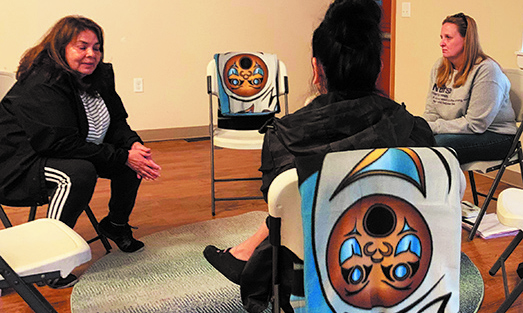
By Shaelyn Smead, Tulalip News
With a total of around 164 deaths from January 1, 2019 to June 13, 2022 within the Tulalip Tribes community, Director of Community Health Verna Hill, and Community Health Nurse, Margarett Agudelo, recognize how much of an issue the rising death toll within the Tulalip community is. Averaging 45-50 deaths per year, with varying reasoning for these deaths, they wanted to find ways to help the community.
“We want to create a space where people can come and be heard.” Margarett said.
That space is a grief support group to help assist with the amount of loss. The group is called Support Circle and serves as a safe place for community members and their families who have lost a loved one, to join together and support one another through their grief and loss. The loosely structured group is designed to create a relaxed atmosphere and a fluid space for exercises, possible art therapy, and simple conversation.
In their efforts to help, Margarett and Verna began sending out grievance cards to the impacted families. A practice that typically isn’t seen within tribal communities, they initiated the effort to help show support to families during such a hard time. They wanted to let the community know that their loved one’s life meant something, and they will honor them, even if it’s with a simple card.
Grief is such a complex and debilitating feeling. And even though people experience grief in many different ways, it is often a long time before anyone can start to feel any level of normalcy. Without any additional mental and emotional support, that journey often can be a much longer one.
The American Psychological Association listed several steps that a person can take when experiencing loss: talking about the death of your loved one, accepting and acknowledging your feelings, taking care of yourself and your family, reaching out and helping other dealing with loss, and remembering to celebrate the lives of your loved ones. All of these steps can be taken and assisted with in the new support group.
Knowing and understanding the importance of getting help is essential, and it can help keep yourself from traveling down a path of unhealthy habits and destructive outlets.
The Hazelden Betty Ford Foundation released an article stating, “There is a relationship between grief and substance abuse in a bidirectional way: people with complicated grief have a higher risk of substance abuse, and people with SUD (Substance Use Disorder) have a higher incidence of loss-related experiences such as death of a loved one and loss of significant relationships.”
In accordance with this information, the Substance Abuse and Mental Health Services Administration (SAMHSA) disclosed that in 2019, 20.4 million Americans battled with substance abuse disorder, with the CDC reporting 70,630 reports of drug overdose related deaths that same year.
“Death is exceptionally painful. And people have to talk about it. If you have a safe place you can go, where you can support each other, and be there for each other, and make that happen, maybe we can avoid some of those destructive habits.” Margarett said.
One of the Support Circle attendees talked about how the death of her mother was one of the most heartbreaking experiences of her life. She spoke of the days when even the distractions she used couldn’t supplement the grief she was feeling.
A variety of stories were shared, similar and contrasting to each other. Every person was able to share what they’ve been through, and the mourning that they’ve felt and still continue to endure. Finding someone to share your experiences with, and knowing that you’re not alone in these hardships brings a sense of comfort that is often hard to find during these times.
With this vicious cycle of grief and substance abuse, you have to wonder what sort of measures the group leaders have taken to fight this. The Support Circle team traveled to California to learn materials to better prepare them for the group and help guide this community and its grief. The Curricula is established from grief counselor, author, and creator of the Centers For Loss and Life Transition Dr. Alan D. Wolfelt, called: ‘Understanding Your Grief’ and ‘Understanding Your Grief Companion Journal’.
Margarett and Verna talked about their new understanding of grief. They know that with complex grief, there is an importance to get help and seek out therapy. But also, with any level of grief, the importance of having a support system. “We learned so much from the course. The idea is that people have to feel their grief, and they have to walk through that process. We’re not treating them, it’s not a medical problem. It doesn’t need a diagnosis, it doesn’t need medicine, it doesn’t need my advice, people just need to be heard. We just have to be there for them” Margarett said.
At every meeting, each new member is given a copy of each of the books so that they can either work on it with the Support Circle, or have them in the comfort of their own home.
When discussions surrounding mental health come about, it is important to understand how it also directly affects our community. We have to find a healthy and honorable way to acknowledge the lives that have been lost, and find a way to move forward for ourselves and our community.
If you or anyone you know is suffering with grief or loss, and think the Support Circle will be helpful, please contact Margarett at 360-926-3764, or Verna at 360-722-6819. The group takes place on Mondays from 12:00 p.m.-2:00 p.m., and Thursdays 6:00 p.m.-8:00 p.m., in the Mission Highlands Community Building at 8226 21st Ave NW Tulalip WA 98271. Sign up for the Support Circle is not necessary and drop-ins are welcome.
Margarett finishes with, “I will be here. Even if no one else shows up, I will be here for whoever wants to come.”
The Salmon Ceremony
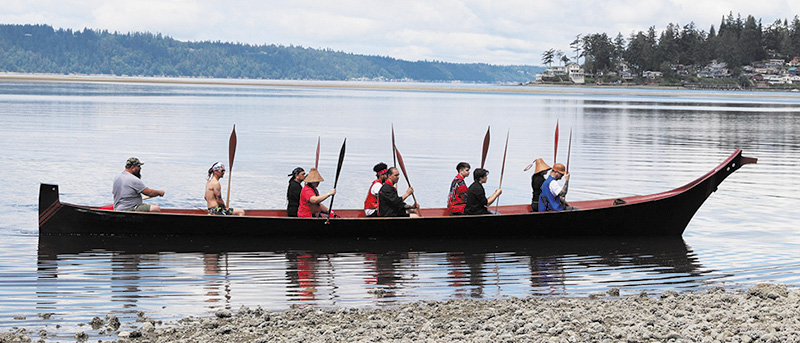
By Kalvin Valdillez, Tulalip News
“The reason Salmon Ceremony is important is because it’s a part of our culture,” said Tulalip tribal member, Josh Fryberg. “We want to preserve it for our future generations while honoring our past generations, who kept the ceremony alive for each and every one of us.”
On the bright and overcast morning of June 11, Tulalip dancers and singers gathered outside of the tribal longhouse. They shared laughter and exchanged many pleasantries while draped in traditional regalia. Cedar-woven hats, headbands, cuffs, waistbands, and jewelry were proudly displayed by the Coast Salish people, as were beautifully designed shawls, vests, ribbon skirts and shirts.

Meanwhile, the community gathered inside the longhouse, and joining them were several members from other tribal nations including Lummi, Swinomish, Quinault and Makah. There were also many non-tribal members in attendance, who wished to learn more about the traditional lifeways of the Tulalip people and witness the important work that is practiced at the start of every fishing season.
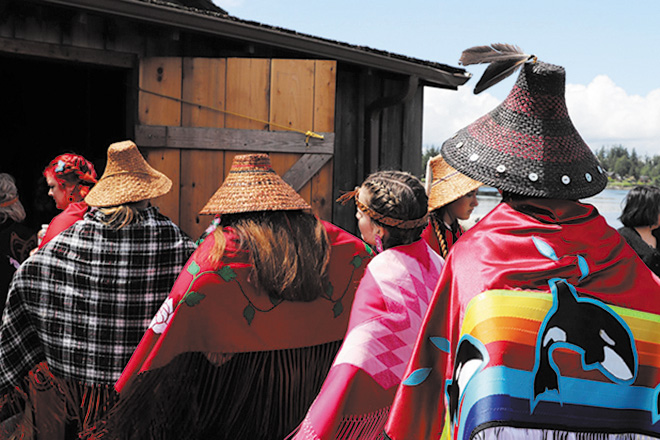
The drummers and singers formed a line beginning at the entrance of the cedar-plank building, and at 10:30 a.m. on the dot, they began to sing Harriette Shelton Dover’s Welcome song as they entered the longhouse, circling the fire at the center of the floor twice.
“This ceremony was taken away from us,’ said tribal member, Arielle Valencia. “It’s good that we’re reclaiming it.”
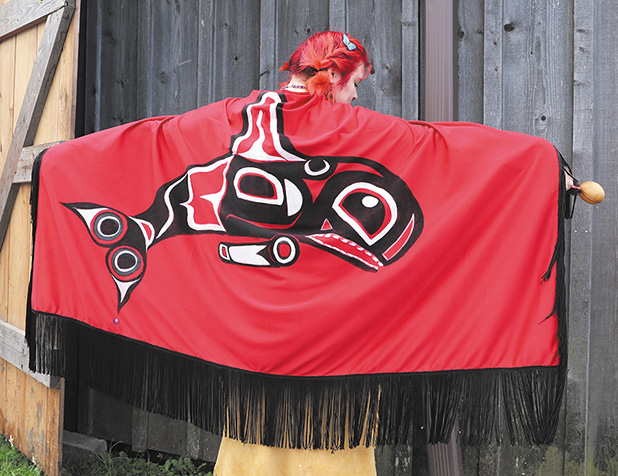
In an attempt to ‘kill the Indian, save the man’, the U.S. Government outlawed cultural and spiritual practices during the early 1900’s. The sduhubš ancestral teachings, language, and traditional way of life were almost completely lost, including the Salmon Ceremony. However, a resilient group of tribal members held onto their teachings while they also endured the horrific boarding school experience.
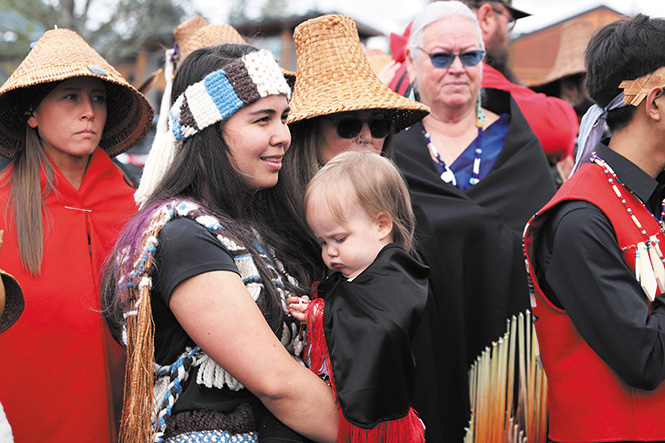
After years of keeping that information tucked away safe in their memory banks, they came together in the mid-70’s and recalled the events that took place at the Salmon Ceremony, sparking a revitalization that grows stronger with each passing year. Leading this revival was none other than Harriette Shelton Dover, who passed on the story of the Salmon People and a handful songs that are a major part of the annual ceremony of honor.
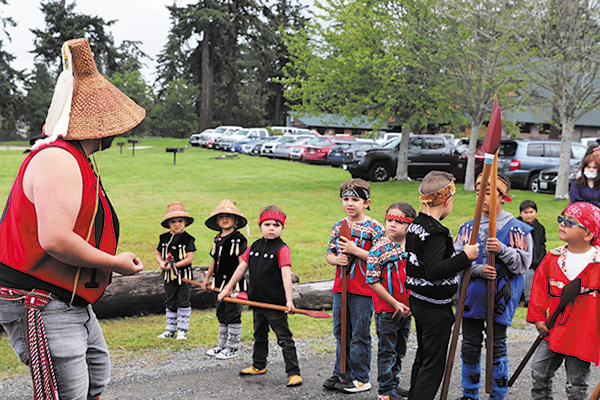
In the early 90’s, Tulalip Leader Bernie ‘Kai Kai’ Gobin shared a retelling of the Salmon People story with the Marysville School District. Kai Kai shared, “The story goes that there is a tribe of Salmon People that live under the sea. And each year, they send out scouts to visit their homeland. And the way that the Snohomish people recognize that it’s time for the salmon scouts to be returning to their area is when, in the spring, a butterfly comes out. And the first person to see that butterfly will run, as fast as they can, to tell our chiefs or headmen, or now they are called the chairman. One of the other ways they recognize that the salmon scouts are returning is when the wild spirea tree blooms. The people call it the ironwood tree, and that’s what they use for fish sticks and a lot of other important things, like halibut hooks. It’s a very hard wood. So, when they see either one of these, a tribal member will tell the chairman, and he immediately sends out word to the people and calls them together in the longhouse for a huge feast and celebration to give honor to the visitors that are coming.”
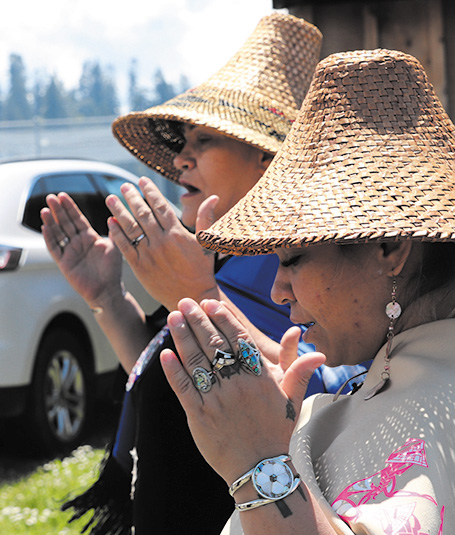
The current Chairwoman of the Tulalip Tribes, Teri Gobin, has a special connection to the Salmon Ceremony and has attended each gathering since it’s revival, as well as every practice leading to the event each year.
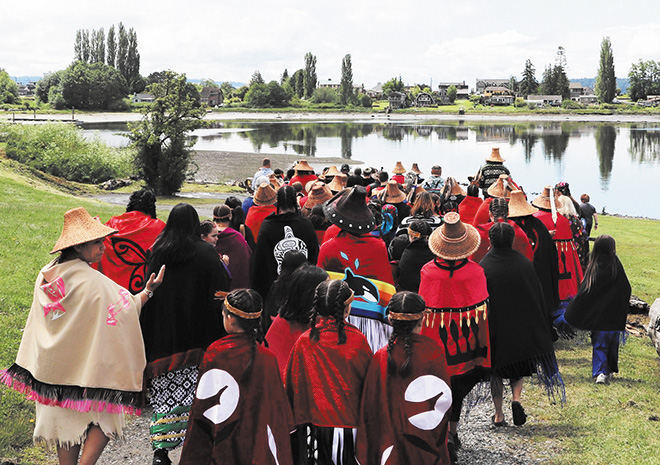
Teri shared, “My father [Stan Jones Sr.] was one of the main people to work with the elders to bring the Salmon Ceremony back. A lot of these songs were almost lost. It was Harriette Shelton Dover and all these iconic elders that wanted to make sure this was carried on. That was so important. My mom was the one who brought the cakes, and we would visit and write everything down to keep it for future generations. And that’s what’s most important, that these young ones are learning now.”
The future of Tulalip was well-represented at this year’s gathering. Youth of all ages took the ceremony very seriously, recognizing the importance of an event that pays tribute not only to the salmon, but to their identity as the descendants of the sduhubš people. Happy to engage in the cultural experience, each time the kids entered the longhouse they went in focused solely on the work that was taking place, and sang and danced with their all.
“It’s important that we understand and learn the songs that have been brought back by the elders, the main songs of the ceremony,” stated young tribal member, Image Enick. “The ceremony is also important because I’ve always thought of it as a good way for the young ones to learn the songs, and what it is to see and show respect. And to actually see the young ones go out there and dance.”
Prior to this year’s ceremony, the Tribe began preparing eight-weeks in advance, giving the participants the opportunity to learn all about the traditional ceremony, and build a strong connection to the songs, stories, dances, blessings and chants. The practices were held at the Tulalip Gathering Hall this year and the tribe conducted an entire walkthrough of the Salmon Ceremony at each practice, taking plenty of time to explain to the youth what the dances and songs mean to their people.
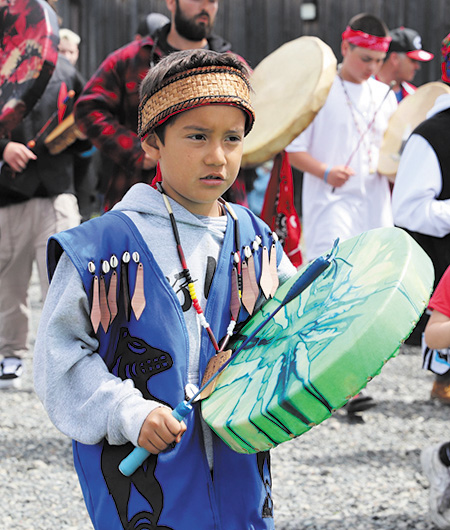
Ten songs and blessings are offered at the Salmon Ceremony and they are performed in the following order:
- The Welcome Song
- Sduhubš War Song
- Eagle/Owl Song (Tribute to Kai Kai)
- Blessing of the Fisherman
- Listen to our Prayers
- hikw siyab yubəč
- The Happy Song
- Table Blessing Song
- Canoe Song (Kenny Moses Jr.’s Song)
- New Beginnings Cleansing Song (Glen’s Song)
Halfway through this year’s ceremony, everything came to a sudden halt when Jaxson Gobin, a young Tulalip tribal member, ran into the longhouse after the blessing of the fisherman and the prayer song ended. Bearing good news, Jaxson informed the people of the arrival of a special guest.
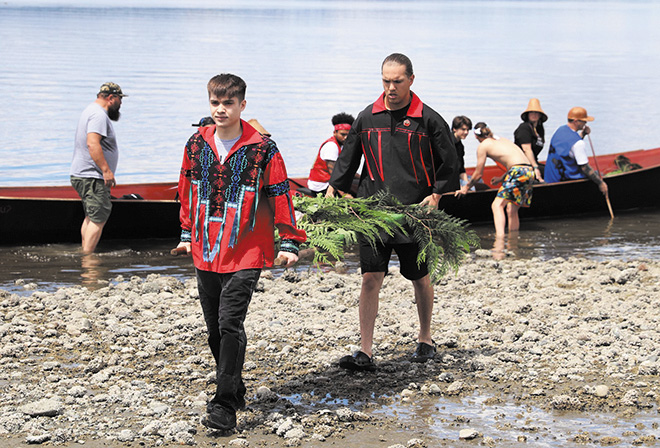
Said Jaxson, “When we sing the prayer song, my grandpa gives me the signal – when to go out. And he tells me when to come back in, which is at the end of the song. Then I yell, the canoe is coming, but isn’t touching the shore yet, with big chief king salmon.”
Hearing of the scout’s arrival at Tulalip Bay, the tribe then began singing hikw siyab yubəč, as they filed out of the longhouse to greet the first king salmon of the 2022 fishing season.
“hikw siyab yubəč is one of the primary Salmon Ceremony songs,” explained Glen Gobin, the Tribe’s official Salmon Ceremony Leader. “We sing this all the way down to the beach once yubəč is here. We sing this to greet our visitor. Once the canoe has landed, and he’s unloaded, he now leads the way. From this point for the rest of the ceremony, he’s at the front, nobody goes in front of him. We sing this all the way to the longhouse and then again when we take him back to the water. We recognize him, give thanks. He is the scout, he comes to see how well we are doing and if we treat him correctly, he’ll tell his people that the Tulalip’s are good people.”
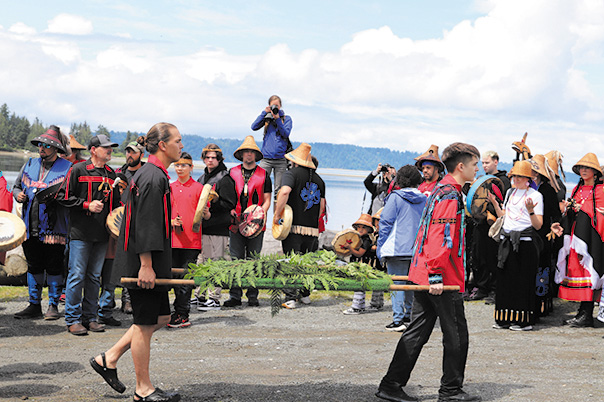
The guest of honor was escorted to the longhouse on a bed of cedar branches and given a tour of where the ceremony takes place, before he was prepared to be shared amongst the entire community together.
The singers, dancers, and witnesses journeyed from the longhouse to the Greg Williams Court, following behind yubəč. Once everybody found their seat, the Tribe performed the Table Blessing Song, a song that has been passed down through thousands of years, as told by Glen. Then they all took their first bite of salmon together, followed by a drink of cool water.
“This first piece is representative of us all sharing the blessing of the yubəč,” said Glen as he addressed the participants in the gym. “I ask that we all eat this piece at the same time together. Now, I’m going to ask that we all take our water and drink it together. This clear water represents the purity of life, and the lifegiving waters in which the salmon come from. Now I’m going to ask that we all eat this wonderful meal together.”
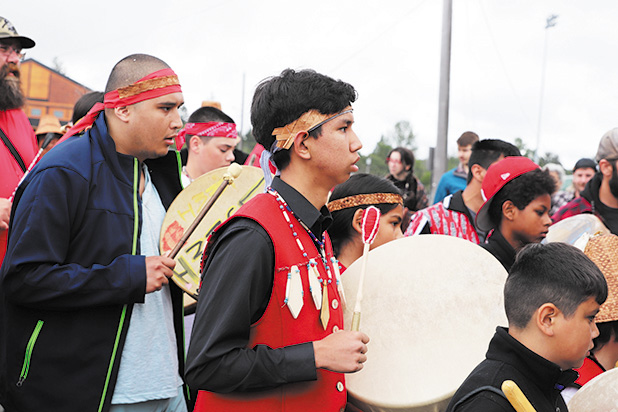
Following the meal, the people brought yubəč’s remains down to the canoe and he was sent back to the Salish Sea to start his journey back to his village, so he could tell the Salmon People how well he was treated by the people of Tulalip. In return, the salmon will frequent the waters of Tulalip Bay this season, where tribal fisherman can catch and bring them into the tribal community, and they can continue providing delicious sustenance for the sduhubš people as they have since time immemorial.
“Salmon Ceremony is about giving respect to those that come from nature,” Glen reflected. “But it also teaches about giving respect throughout life and honoring those gifts that we get, and respecting our way of life in a good way. Part of that is making sure how we sing the songs, how we conduct ourselves, it teaches how to carry yourself in life. All of the songs have meaning, everything is connected. The songs encourage the people to carry themselves in a good way.”
He continued, “Today was great. The longhouse was full. The floor was extremely full. It’s great to have that problem, to have all the young people circling that floor and still coming through the door. The kids did great. The songs were all together, everything sounded great and everybody looked great. I think the ancestors would be very proud, and are very proud, of the work we are doing.”
June 11, 2022 syəcəb
Please use the following link to download the June 11, 2022 issue of the syəcəb
Pendleton’s iconic wool wear now available at Seattle Premium Outlets
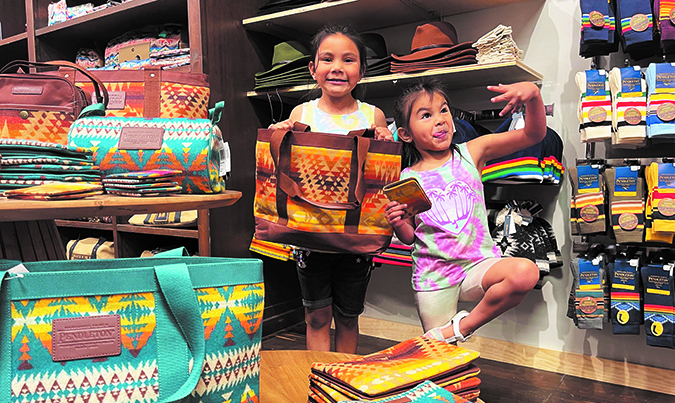
By Micheal Rios, Tulalip News
Uniquely woven into Native communities, Pendleton Woolen Mills continues to partner with and share traditional Native design and artistry with the world. Known for their vibrant colors and distinctive patterns, Pendleton blankets and jackets have been embraced by the Tulalip Tribes for generations. From graduation gifts to burial shrouds, from decorative wall hangings in tribal member homes to staple items in gift shops of both the Tulalip Resort and Hibulb Cultural Center, Pendleton is synonymous with Native pride and heritage.
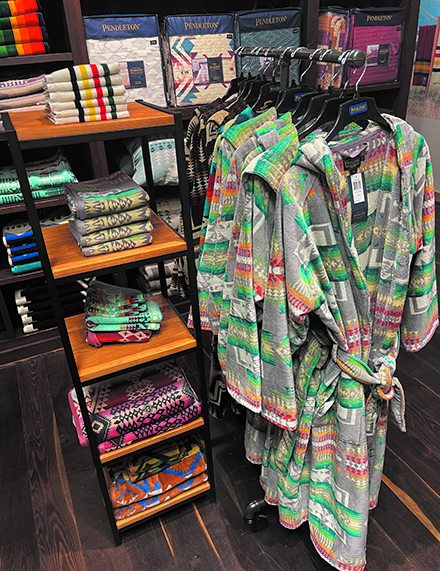
The connection with Tulalip will continue to grow and evolve now that a Pendleton store has officially opened at Seattle Premium Outlets. The iconic wool wears have never been more accessible to the local community with huge discount savings and exclusive tax exemption for Tulalip citizens.
Seventeen-year-old tribal member and soon to be Marysville Getchell graduate, Alaqua Spencer, visited Pendleton on its ceremonial grand opening. She perused many of the store’s offerings before falling in love with a signature zip-front wool jacket. She shared, “This was my first time ever inside a Pendleton store. Seeing all the cool Native designs on so many different items was amazing. I bought a gray and black jacket that I absolutely love.”
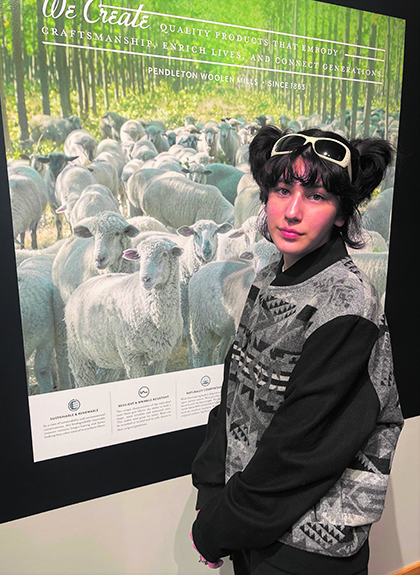
Fellow Tulalip citizen Udora Ceja was excited to visit the outlet’s latest addition as well, while her 6- and 5-year-old daughters scurried around, checking out all the colorful purses and handbags. They could be heard arguing over which bag was prettiest, but before coming to an agreement, the 5-year-old darted off after catching a glimpse of a cute pair of baby booties.
“We were walking around the Outlet and saw the sign saying ‘Pendleton: Now Open’ and we had to check it out,” shared Udora after coming away happy with several purchases. “It was a good opportunity to pick up some cool Father’s Day gifts. I was surprised to see they have so many nice designs and stunning graphics. I didn’t know Pendleton made so many products outside of blankets and jackets. And the prices are really good, too.”
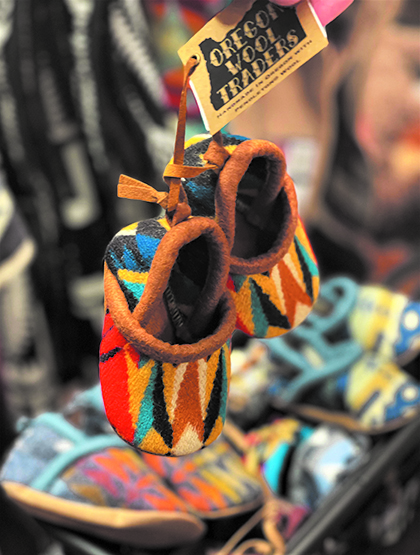
Pendleton has long held connections with wool ranchers across the nation, with some providing wool to Pendleton for nearly a century now. Not only is much of their wool grown in the U.S., it’s also milled in Pendleton’s Oregon and Washington factories. Adding another layer of connectiveness to past Tulalip generations that wove every day garments from mountain goats and the legendary wooly dogs.
Wooly dogs were a specialty breed that the Coast Salish held in high regard, to the point their caretakers kept the coveted source of fur on nearby islands to prevent crossbreeding. The dogs were sheared every summer and their warmth generating wool was used to make protective layers during the winter months. According to local historians, the wooly dog breed went extinct in the early 1900’s.
In the absence of the wooly dog, sheep quickly became the alternative wool of choice as it’s a natural, durable fabric that can better withstand the natural elements associated with the Pacific Northwest. Modern wool is one of the most sustainable sources for textile use as fleece regrows every year. Plus, sheep wool naturally resists odor, stains and soiling.
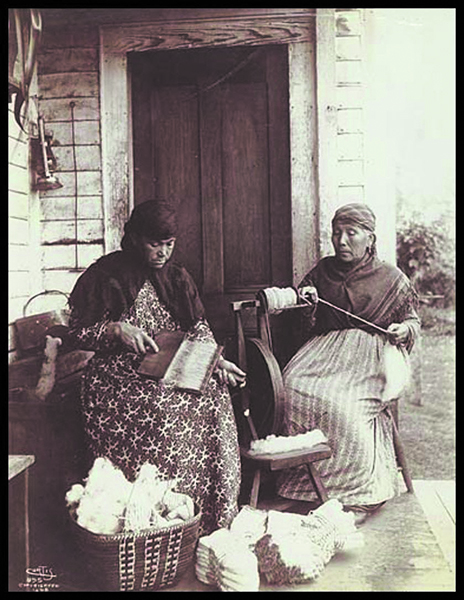
Photo by Edward Curtis.
Since 1909, Pendleton has produced Native-inspired blankets, robes and shawls for tribes across the continent. Today, Pendleton maintains its connection to the Native American population by uplifting Native artists and supporting a variety of Native causes that make a real-world impact.
In partnership with the American Indian College Fund, Pendleton creates wool blankets whose proceeds are collected and disbursed as college scholarships for the next generation of Native scholars. In fact, Pendleton has provided nearly $1.65 million in higher education support for Native students to date.
Self-taught ledger artist, beader, graphic designer and painter from Montana’s Fort Peck Reservation, Chelysa Owens (Fort Peck Assiniboine & Dakota Sioux) is an American Indian College Fund scholar and 2021 Tribal College Blanket Contest winner. Her art is represented by Pendleton’s ‘Unity’ pattern.
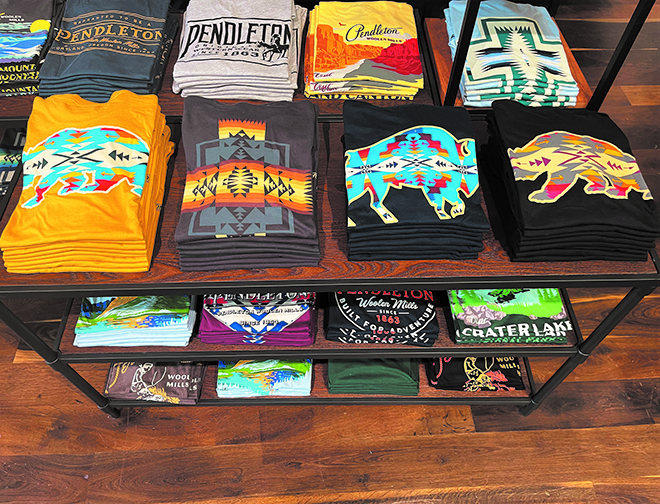
“Pendleton is one of my favorite brands,” she said. “They work with the artist to get the work as close to our vision as possible. I’m living the dream at such a young age because I have always wanted to be a graphic artist. This just adds to my art journey, which is a good feeling. I would like to give a huge thank you to Pendleton Woolen Mills and the American Indian College Fund for giving this amazing opportunity to tribal college students and allowing others and me to showcase our talents and share our visions with you.”
Pendleton is also tied to the Water Is Life movement with their most recent Native artist collaboration. Emma Robbins (Diné) is an artist, community organizer, and Executive Director of the Navajo Water Project. This community-managed utility alternative brings hot and cold running water to homes without access to water or sewer lines. The blanket she designed, the Gather Blanket, costs $279 on the Pendleton website. A portion of each sale goes to support the Navajo Water Project.
“This is a dream of mine, to work with a company like Pendleton. We grew up with Pendleton all around us, and even though the company isn’t necessarily traditional, it’s such a big part of our tradition,” said Emma to the Navajo Times. “And it’s exciting that we’re working with Pendleton because not only is it good to get those proceeds and get them back home to do running water systems, but also spread the word about the project and water issues and solutions that are being implemented by our people.”

The Northwest based manufacturer of everything wool offers a variety of products that prominently feature Native-inspired designs. Pendleton elevates the voices, work, and representation of tribal college students, artists and impact makers, while providing scholarship opportunities and a variety of products associated with important events.
For the Tulalip community, the long-awaited arrival of a Pendleton store at the local outlet mall means the highest grade of locally sourced, sustainable woolen blankets and jackets will continue to be associated with ceremonial giveaways and rites of passage. Like the tradition of gifting newly minted Tulalip seniors a Pendleton blanket or gifting a high school graduate a Pendleton jacket to rep with pride. This is a relationship sure to thrive even more going forward.
Stick Games Tournament Returns
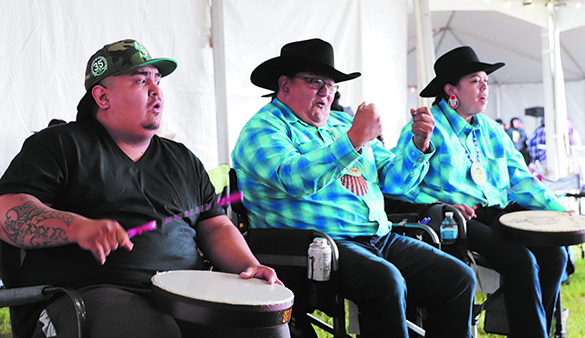
By Kalvin Valdillez, Tulalip News
For nine consecutive years, the Tulalip Tribes hosted an annual Stick Games Tournament at the start of every summer. Typically held during the first weekend of June, the tournament takes place at the Tulalip Amphitheater and attracts tribal members from all throughout the Northwest region, including many families hailing from First Nation Bands in British Columbia.
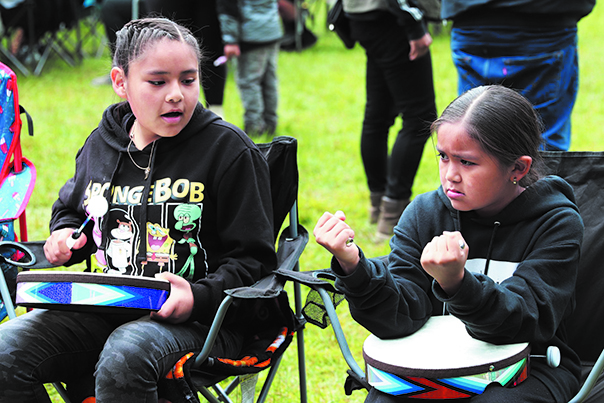
The worldwide pandemic put most social gatherings and events on-hold to limit the spread of the communicable disease. And to the dismay of many lifelong stick games players, the tournament was canceled in both 2020 and 2021. The cancellations, however, made the return of the tournament all the more exciting as hundreds of Natives showed out for this year’s competition during the weekend of June 3rd-5th.
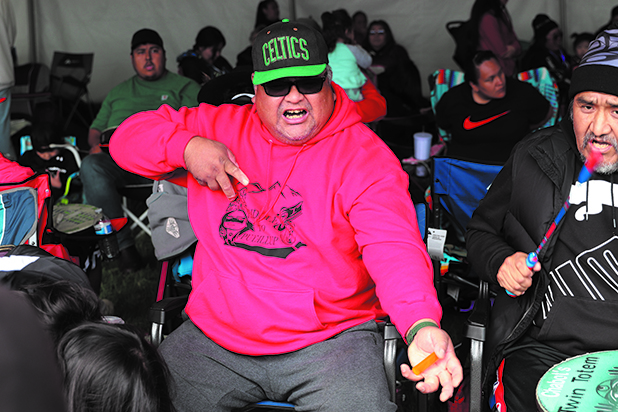
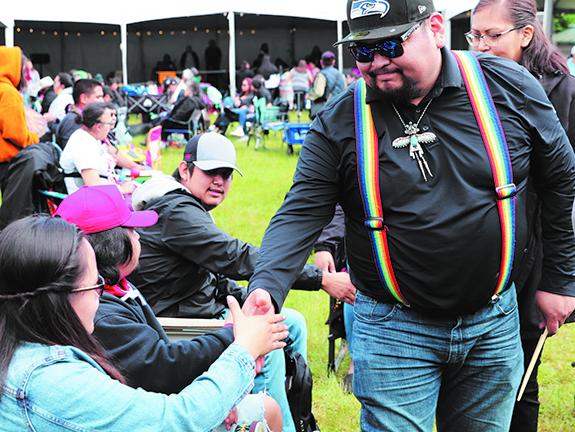
“It’s nice to visit with family who I haven’t seen in forever,” exclaimed Spokane tribal member and Tulalip community member, Marsella Gonzalez. “I played all weekend. I used to play every year before COVID happened, so I haven’t played in a long time. It’s fun and enjoyable to gather together again and play against one another, as well as getting to know more people from other tribes. It’s great to see everybody out and about and enjoying each other’s company.”
Stick games, also known as bone games, hand games, slahal, and lahal, is a traditional game that was gifted to the coastal people in ancient times. The game was taught to the people by the animals of the region as a means to settle a multitude of intertribal disputes regarding hunting and fishing grounds, as well as to prevent warfare between tribes. For generations tribal nations have passed down the knowledge of how to play the game, which requires the skill and mastery of deception and distraction.

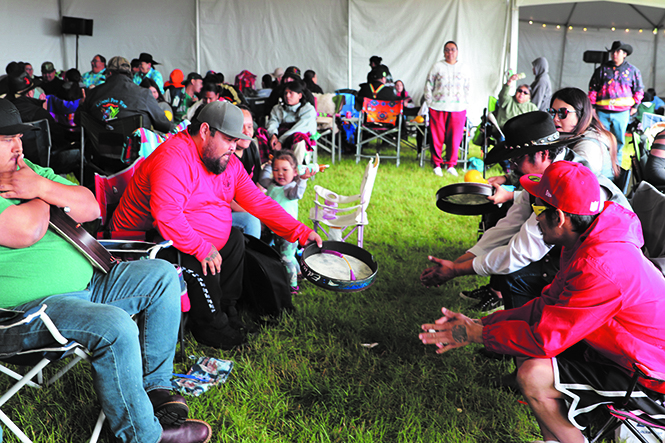
Gameplay requires two opposing teams, consisting of three to five players, to face-off against each other. The game pieces, which includes a set of bones and sticks, are discreetly distributed amongst the players on one team. The opposing team must correctly guess where the bones are hidden and how many pieces the player has concealed in their hands. The sticks are used to keep score. The team with their bones in-play, sing traditional family songs in an attempt to distract the other team from seeing who the bones are given to. The team that has the most correct number of guesses wins the game and advances to the next round.
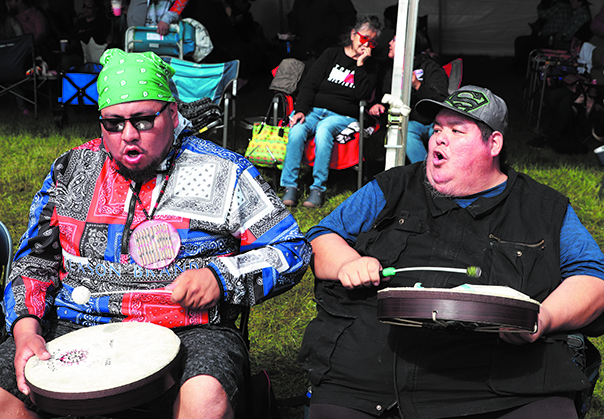
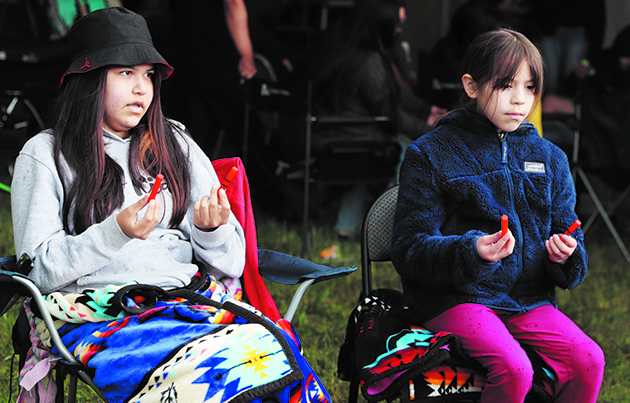
There are a number of unofficial game pieces as well that helps teams immensely during a stick game tournament, such as foldable lawn chairs so that teams can quickly set-up against their opponents and move and play about the grounds; pull-over hoodies so a player can hide the bones in their front pockets, and also bandanas for the same reason. And finally, traditional hand-drums so your team can sing loud and distract the opposing team while the bones are passed amongst the team.
Said Marsella, “I love hiding the bones. It’s nerve-racking but it’s exciting because you’re trying to keep them hidden so well. I was taught not to look people in the eyes when playing, and I did it twice this weekend and got caught each time. The game is amazing to play. Next, I have to learn more songs.”
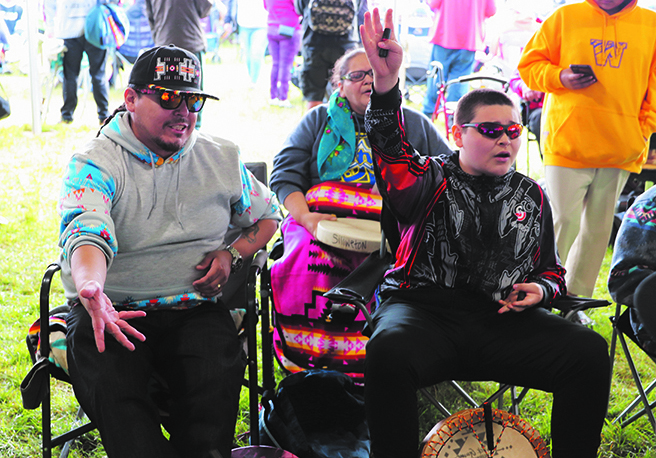
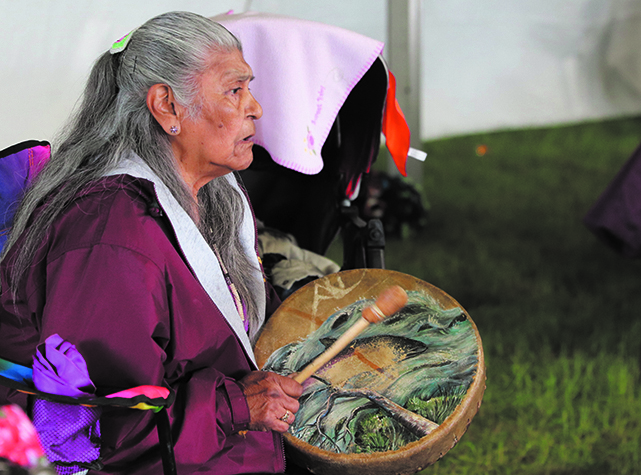
Another highlight of the tournament is shopping and supporting local Indigenous artists, chefs, and entrepreneurs as numerous vendors set-up shop at the amphitheater each year. Several Tulalip tribal members were in attendance this year, selling their trademark goods to event-goers including Josh Fryberg and family who sold hoodies and smoked salmon, Jared Parks sold his signature sweet-and-salty kettle corn, Natosha Gobin had natural salves and balms available for purchase, and Winona Shopbell-Fryberg and Santana Shopbell-Proehl had a selection of beadwork for sale.
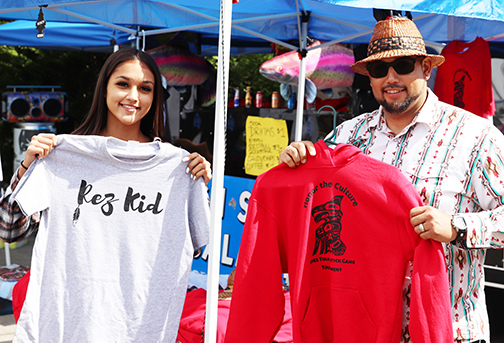
The participants of the Tulalip Stick Games Tournament compete for the chance to take home a cash prize. This year many cash prizes were awarded, including the grand prize of $50,000. In addition to the main competition, several mini-tournaments are held throughout the weekend such as the three-man tournament and the kid’s tournament, and many rounds are also played during open-games on the opening day of the weekend-long event.

“I am a 5th generation stick game player, it’s been a part of my family since the beginning of time pretty much,” said young Lummi tribal member, Tavis Washington Jr. “It feels great to come out after the pandemic and see all the people I usually see at these kind of events, and to meet new people too. My favorite part of the game is winning! Shoot – I like when my team or my family wins a lot. But it feels like it’s been forever since we last played and I am just happy to be back here playing at Tulalip.”
Following the Salmon Ceremony Part 7: yubəč approaches
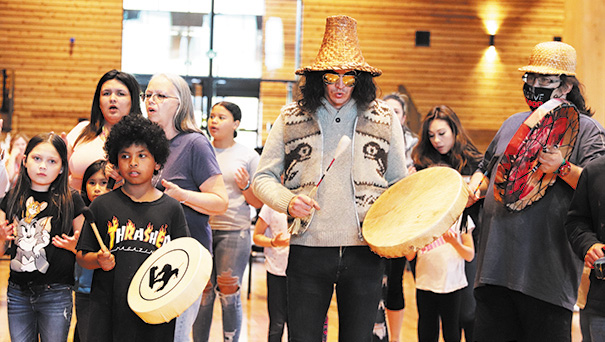
By Kalvin Valdillez, Tulalip News
It has been an amazing journey following the Tulalip community as they prepared for the annual Salmon Ceremony over the past several weeks. Throughout this time we learned of the ceremony’s revival, led by Harriette Shelton Dover and a number of elders in the mid-70’s, as well as all the spiritual work that goes into the special honoring. We revisited a fabulous retelling of the traditional Tulalip story, Salmon Man, by Bernie ‘Kai Kai’ Gobin, and we took a deeper look into the ten songs, chants and prayers that are offered at each Salmon Ceremony.
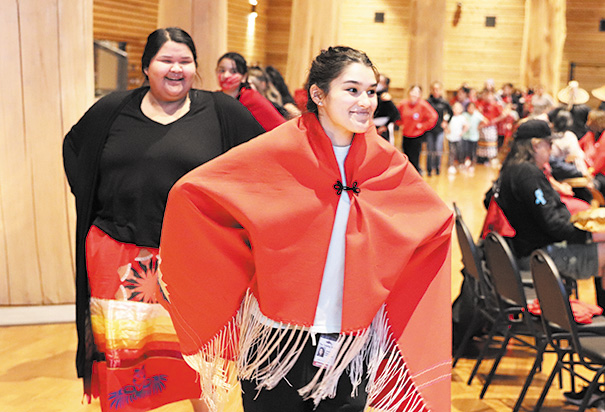
Another highlight of this mini-series was getting to know the participants, who showed time after time why this cultural event is important to them, as they left their all on the floor during each practice. The participants also helped raise awareness for the MMIP epidemic during a special candlelight vigil following a practice session. And of course, we shared the significance of traditional regalia and the role that shawls have in the longhouse.
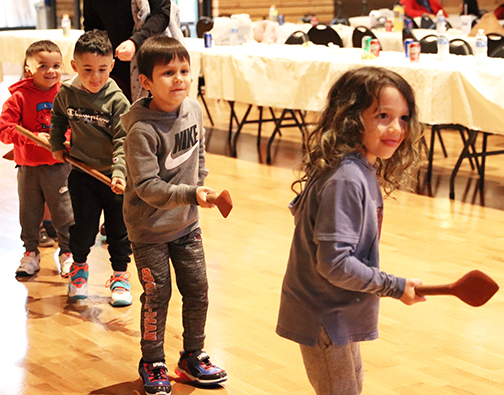
With only two practices remaining, June 2nd and 9th, this will serve as the last installment of the series before the event takes place on June 11th. We couldn’t think of a better way to bring this series to a close than sharing a selection of photos from the practices leading up to the day when yubəč, the king salmon, arrives at Tulalip Bay. As a reminder, the last practice will begin at 5:00 p.m. at the Tulalip Longhouse. The Salmon Ceremony will be held at the Tulalip Longhouse as well, on June 11th, starting at 10:30 a.m.
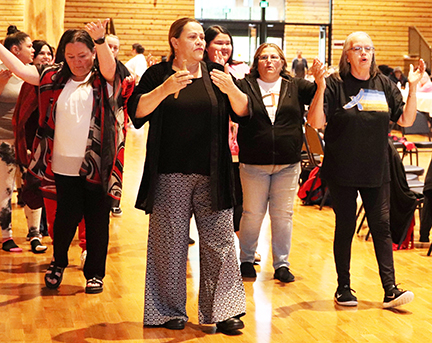
Tribal leaders are inviting the entire community of Tulalip to the last two practice sessions, where a complete walkthrough of the event will take place so that the participants can connect and learn the power behind each song and dance.
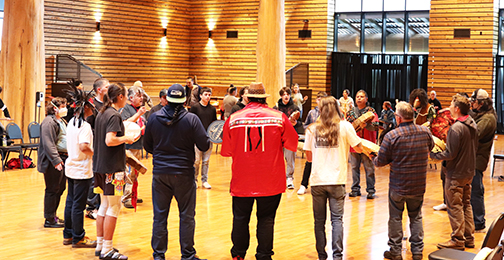
Said Tulalip Chairwoman Teri Gobin, “We’ve come a long way and we’ve been practicing for a lot of years. What is most important now is that we are making sure the young ones are learning the songs, the dances and about those elders who brought it back again.”
See you at Salmon Ceremony!
June 4, 2022 syəcəb
Please use the following link to download the June 4, 2022 issue of the syəcəb
Leveling up in the educational journey
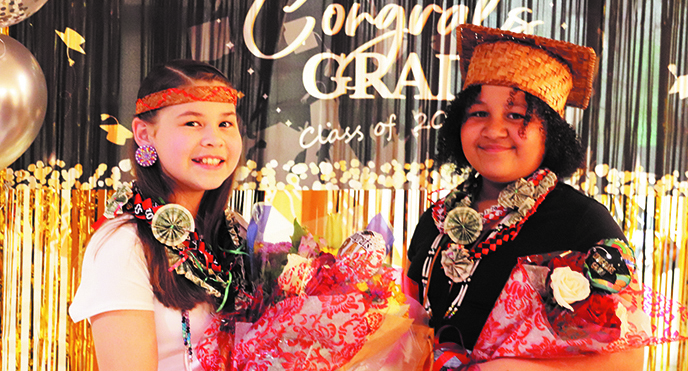
By Kalvin Valdillez, Tulalip News
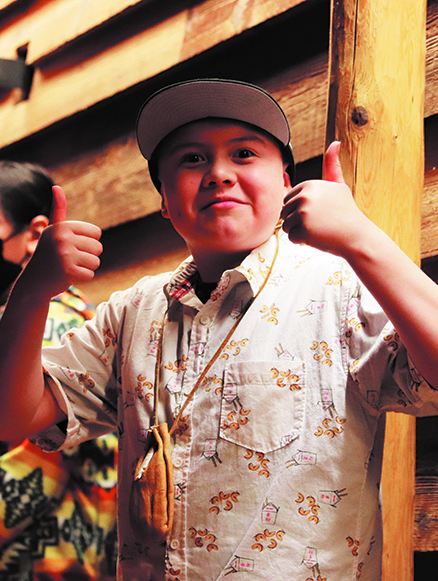
It is that time of year again. Sometimes referred to as cap and gown season, the beginning of summer marks the end of yet another academic year. Young students are often filled with optimism and pride as they close their school year strong before the summertime break, and look forward to a new opportunity come Fall as they begin the next grade in their education career. High school and college graduates are celebrated for their major achievements before they move onto the next challenge and phase of their lives.
There are a few other transition periods that young students go through in the pursuit of diplomas and degrees, including the completion of elementary and junior high school. Big changes lay ahead for this year’s group of 5th and 8th grade students, and the community showed their love and support for the local students who recently leveled-up in their educational journey, moving up to middle and high school respectively.
5th Grade Honoring: Next Stop – Junior High
Nearly 40 young Native American students will be taking the next step in their education journey next Fall as they move on from elementary school to middle school. A handful of students gathered at the Hibulb Cultural Center on the evening of May 25th and the young learners were recognized for all their hard work and academic achievements.
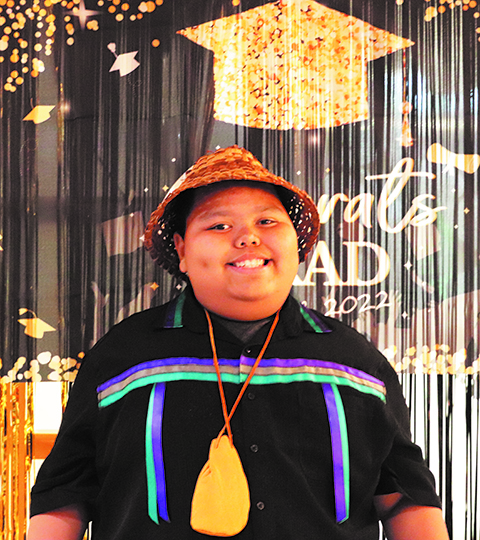
“I graduated from Kellogg Marsh and I am going to Cedar Crest,” said 5th Grade Graduate, Marco Garcia. “Going into middle school, I am most looking forward to art!”
The annual 5th grade honoring was co-coordinated and funded by the Tulalip Education Division and Positive Youth Development team. The honoring united students from over ten different elementary schools throughout the district.
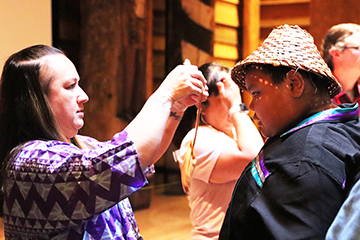
The new middle schoolers formally met the Marysville School District Native liaisons as well as some of their future classmates. The Tulalip Youth Council was in attendance and invited the recent graduates to participate in local events for the youth, and also encouraged the kids to run for the youth council during next year’s elections.
Both Tulalip tribal leaders and MSD officials shared inspiring words with the students about the value of a good education as well as the importance of continuing to learn and practice their cultural teachings. Pixie Owyen was also honored for her work with the Native MSD students over the past 28 years.
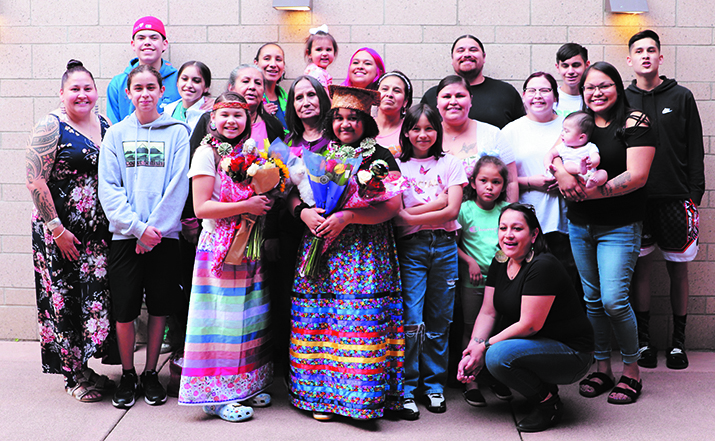
Young Madison Sheldon proudly expressed, “Today was a day of honoring, when 5th graders graduate from elementary school. I’m coming from Liberty elementary. I’m trying to go to 10th street middle school, and I am on the waiting list. I’m looking forward to getting good grades and trying to meet my goals.”
8th Celebration: On to High School
On May 31st, the Tulalip Education Division and the Marysville School District Indian Education department held a special ceremony at the Greg Williams Court gymnasium.
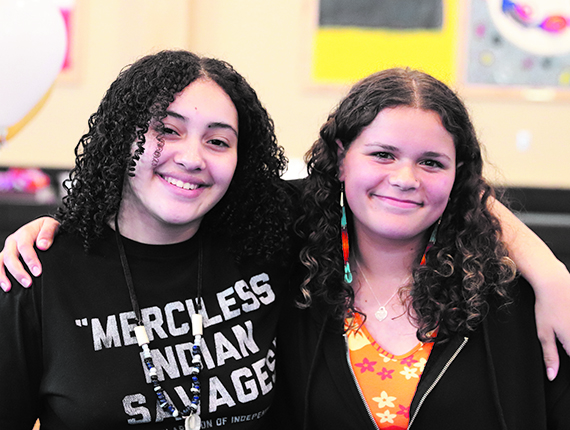
Proud parents, grandparents, aunties and uncles celebrated approximately twenty local youth, consisting of both Tulalip tribal members and other tribal members, who completed their journey in junior high this year.
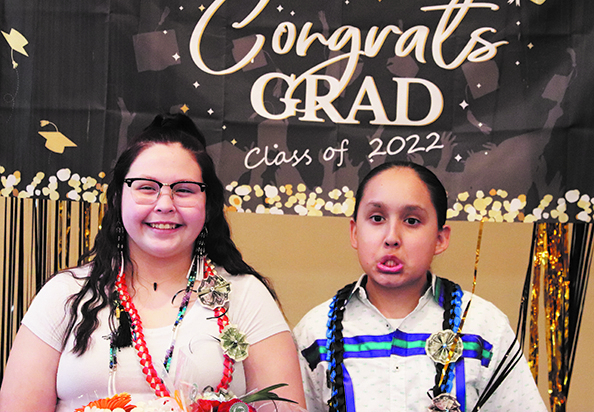
“Today was good, I feel really happy,” stated 8th Grade Graduate, Amaya Hernandez. “I am graduating from Immaculate Conception and Our Lady of Perpetual Help and I am going to Archbishop Murphy High School. I am looking forward to sports the most – volleyball, basketball and softball. And my long-term goal – I want to be a doctor!”
Moving on to high school from middle school is a big step and a number of tribal leaders offered words of encouragement to the students, including Chairwoman Teri Gobin, the MSD Native Liaisons, and Montana State University Hooper RaeQuan Battle. The Marysville-Getchell Native American and Friends club attended the celebration and introduced themselves to the soon-to-be freshmen while inviting them to join the club.
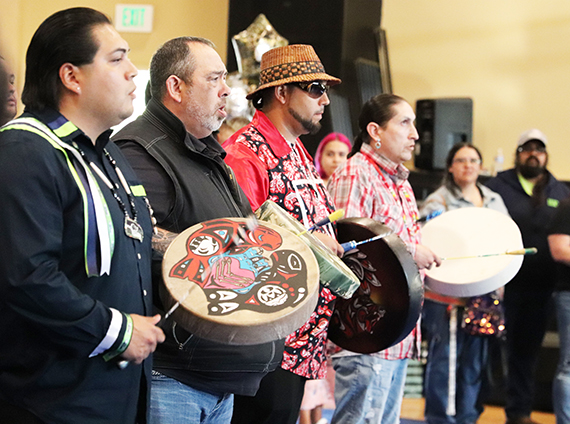
Lushootseed Language Warrior Maria Rios was honored as well for her dedication to revitalizing and preserving the traditional Tulalip language and passing on her teachings to the students of MSD throughout the years.
Following the moving ceremony, the celebration closed with traditional song and dance. The kids were dressed in their regalia. Wearing ribbon shirts and skirts, they took to the floor as everyone gathered in a circle and drumbeats echoed through the gymnasium.
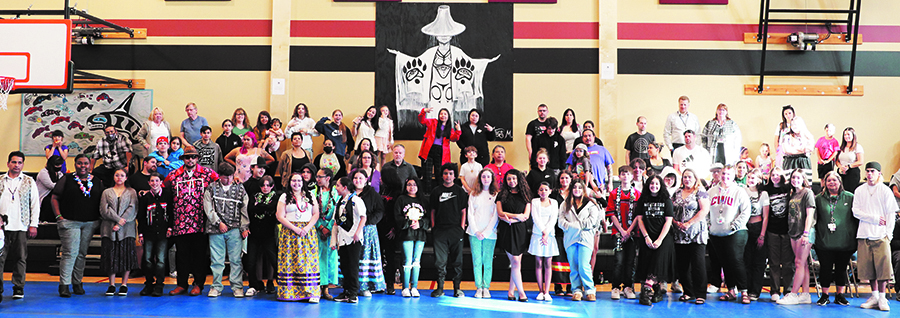
Said young graduate, Raylee Lewis, “We celebrated our years through school tonight by using our cultural teachings. We did the honoring song, the welcoming song. We all got to eat and celebrate with our families and teachers. Connecting with my roots is really important, and I’ve done it my whole life. As I’ve grown older, I realized the significance of it and being with my community, and how it will help me grow and everybody else grow. This makes me feel really happy because I knew a lot of these kids since preschool. I am going to do running start, that’s my biggest goal for high school – and learning Lushootseed!”
Congratulations to all the graduates!